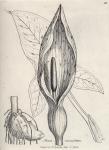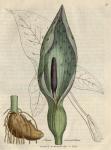
 Synonyma. Arum. Pharm. Lond. & Edin.
Synonyma. Arum. Pharm. Lond. & Edin.
Arum foliis sagittatis, spatha recta, clava cylindrica. Hal. Stirp. Helv. n. 1302.
Arum minus. Camerar. Epit. p. 367.
Arum maculatum et vulgare non maculatum. Bauh. Pin. 195.
Arum vulgare maculatum et non maculatum. Park. 372.
Arum vulgare. Gerard. H. 834. Raii Hist. 1208.
Wake-Robin Cuckow-pint. Raii. Synop. 266.
Arum Maculatum. Flor. Dan. 505. Flor. Lond. Withering's Bot. Arrang. 1012. Relhans Flor. Cant. 342.
Varietates sunt
α, Arum vulgare non maculatum. Bauh. Pin.
β Arum maculatum, maculis candidis, vel nigris. Bauh. Pin.
γ Arum italicum, foliis hastatis acutis, petiolis longissimis, spatha maxima erecta. Mill. Dict.
Class Gynandria. Ord. Polyandria. L. Gen. Plant. 1028. [Arum, by a modern botanist, is arranged under the class Monoecia.]
Ess. Gen. Ch. Spatha monophylla, cucullata. Spadix supra nudus, inferne femineüs, medio stamineus.
Spec. Char. A. acaule, foliis hastatis integerrimis, spadice clavato.
The root is perennial, tuberous, about the size of the thumb, sending off many long simple fibres: the leaves are commonly three or four, growing from each root; these are arrow-shaped, of a deep green or purplish colour, beset with many veins and dark spots, and stand upon long grooved and somewhat triangularly shaped footstalks; the flower stalk is very short and channelled; the calyx is a sheath of one leaf, large, oval, nerved, and enclosing the spadix, which is round, club-shaped, fleshy, above of a purple colour, below whitish, standing in the centre of the sheath, and supporting the parts necessary to fructification: on tracing it towards the base we first discover the nectaries, or several oval corpuscles, which are terminated by long tapering points; next to these are placed the antherae, which are quadrangular, united, and of a purple colour; under these we find again more nectaries, and lastly the germina, which are very numerous, round, without styles, and crowned with small bearded stigmata. This curious species of inflorescence displays itself early in spring, but the berries do not ripen till late in the summer, when they appear in naked clusters, of a bright scarlet colour, making a conspicuous appearance under the hedges, where they commonly grow.
The root is the medicinal part of this plant, which in a recent and lactescent state is extremely acrimonious, and upon being chewed excites an intolerable sensation of burning and pricking in the tongue, which continues for several hours: when cut in slices and applied to the skin, it has been known to produce blisters. This acrimony, however, is gradually lost by drying, and may be so far dissipated by the application of heat, as to leave the root a bland farinaceous aliment; [In this state it has been made into a wholesome bread. It has also been prepared as starch. The root, dried and powdered, is used by the French to wash the skin with, and is sold at a high price, under the name of Cypress Powder: It is undoubtedly a good and innocent cosmetic. Withering, l. c. —These roots are also said to possess a saponaceous quality, and have been used in washing linen, to supply the place of soap. Raii Hist. p. 1208.] its medical efficacy therefore resides wholly in the active volatile matter, and consequently the powdered root must lose much of its power on being long kept, a circumstance which very properly caused the omission of the Pulvis ari compositus in the last edition of our Pharmacopoeia. Lewis says, "the fresh and moderately dried roots were digested in water, in wine, in proof spirit, and in rectified spirit, with and without heat: the liquors received no colour, and little or no taste. In distillation neither spirit nor water brought over any sensible impregnation from the Arum. The root, nevertheless, loses in these operations almost the whole of its pungency." [Lewis M. M. 119.] The qualities of this root are thus enumerated by Bergius: "Virtus recent. siccatae: stimulans, aperiens, incidens, diuretica; recentis vehemtentissima; annosae nutriens." [Tales radices Ari annosae vix acres sunt, prout supra monuimus, & quae restare potest acrimonia, mitigatur penitus ebullitione. Caeterum plures Ari species apud varias gentes esculentas sunt. Nutriunt omnes suo sarinoio. Bergius, l. c.] [M. M. 722.]
— Dr. Cullen [M. M. vol. 2. 212.] seems to consider it as a general stimulant, not only exciting the activity of the digestive powers, where they happen to be languid, but stimulating the whole system; in proof of this he observes, that it has been useful in intermittent fevers. Arum, by ancient writers, is much commended, both as an external and as an internal remedy, and is said that "Ratione particularum tenuium & volatilium mucum viscidum & spissum ventriculi & intestinorum parietibus adhaerentem potenter incidit, attenuat, atque resolvit;" and was prescribed in all that numerous class of diseases formerly supposed to proceed a succorum lentore. Bergius considers it useful in Colluvies pituitosa, Anorexia, Cephalasa sympatica, [Bergius speaks highly of the efficacy of Arum in these headachs, which were of the most violent kind, and resisted all the means he employed, till he used the powder of this root, which never failed to relieve them.] Asthma humorale, Cachexia, Febris intermittens. Arum is certainly a very powerful stimulant, and by promoting the secretions may be advantageously employed in cachectic and chlorotic cases, in rheumatic affections, and in various other complaints of phlegmatic and torpid constitutions; but more especially in a weakened or relaxed state of the stomach, occasioned by the prevalence of viscid mucus. If this root is given in powder, great care should be taken that it be young and newly dried, when it may be used in the dose of a scruple or more twice a day: but in rheumatisms and other disorders requiring the full effects of this medicine, the root should be given in a recent state, and to cover the insupportable pungency it discovers on the tongue, Dr. Lewis advises us to administer it in the form of emulsion, with gum arabic and spermacaeti, increasing the dose from ten grains to upwards of a scruple three or four times a day; in this way "it generally occasioned a sensation of flight warmth about the stomach, and afterwards in the remoter parts manifestly promoted perspiration, and frequently produced a plentiful sweat. Several obstinate rheumatic pains were removed by this medicine, which is therefore recommended to further trial."

